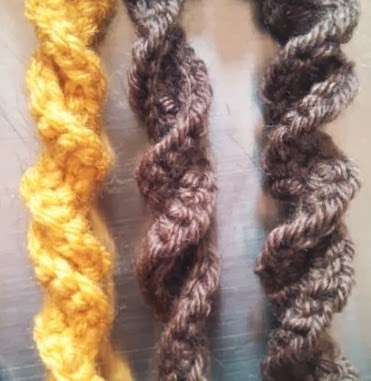 |
| From left to right: crocheting RIGHT handed; crocheting LEFT handed, and crocheting BACKWARDS RIGHT handed. |
I've been interested in finding ways to represent biological molecules at something representing an accurate scale. To that end, I though it would be awesome to have a standard way of making a double helix of DNA. I tried a bunch of different stitch heights and increase ratios, and it turns out that something very simple works pretty well!
1. Make a chain of length = # desired base pairs/2
2. Chain 1
3. In 2nd chain from hook, make two single crochets in top loop. Repeat for each chain stitch.
4. At end, chain 1, slip in same stitch, chain 1.
4. Turn work
5. Beginning with the last-worked stitch in the base chain, make two single crochets in bottom loop of the base chain. Repeat for the remainder of the work.
This yields a helix with about 10-11 base pairs per turn - there's even a major and minor groove! One problem, though - if you do this RIGHT HANDED, you will end up with a left-handed helix. The double helix is in fact right-handed. (For more on helix chirality, check out figure 1.2 here) See the yellow helix in the picture above.
To solve the problem, I've been practicing crocheting LEFT HANDED. This was painfully clumsy at first, but also illuminating. I teach beginners to crochet from time to time, and this has given me fresh insight on how difficult and important tension is. With a bit of practice, I can get a more or less even helix (middle swatch in the photo above).
Though I'm improving, it's slow going. Once again Sandy suggested a clever solution to this problem: crocheting right handed, but BACKWARDS. In other words, inserting the hook through the loop of the chain back to front rather than front to back. Here's a tutorial for backwards crochet (note that this appears to be distinct from reverse crochet or crab stitch). One caveat, though - I've been seeing different stitch heights if I don't grab the yarn correctly to pull it through (ie, if I let it wrap around the hook). While barely noticeable on a stitch by stitch level, this has HUGE effects on the helix. Perhaps due to clumsiness or loose tension, the resulting helix (right, in the photo above) is still not as nice as the one I made working left handed, though I could tell I was working a bit faster. Was it worth it?
To answer this question, I timed myself. I can make 7 stitches a minute working left-handed, 8 working backwards right-handed, and 29 working right handed. It's probably time to take the advice in this helpful tweet:

Comments